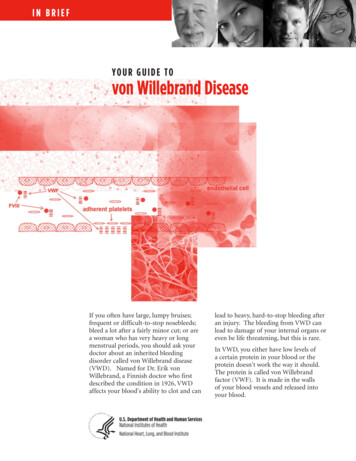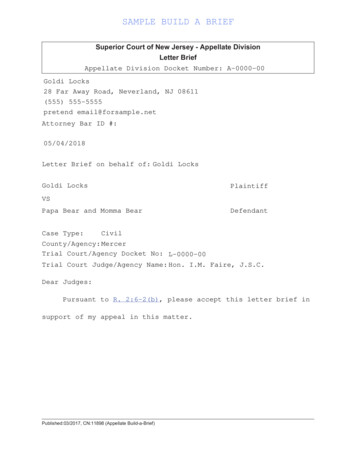
Transcription
IN BRIEFYO U R G U I D E TOvon Willebrand DiseaseIf you often have large, lumpy bruises;frequent or difficult-to-stop nosebleeds;bleed a lot after a fairly minor cut; or area woman who has very heavy or longmenstrual periods, you should ask yourdoctor about an inherited bleedingdisorder called von Willebrand disease(VWD). Named for Dr. Erik vonWillebrand, a Finnish doctor who firstdescribed the condition in 1926, VWDaffects your blood's ability to clot and canlead to heavy, hard-to-stop bleeding afteran injury. The bleeding from VWD canlead to damage of your internal organs oreven be life threatening, but this is rare.In VWD, you either have low levels ofa certain protein in your blood or theprotein doesn't work the way it should.The protein is called von Willebrandfactor (VWF). It is made in the wallsof your blood vessels and released intoyour blood.
Normally, when one of your blood vesselsis injured, you start to bleed. As soon asthis happens, small cells in your blood thatare called platelets clump together to plugthe hole in the blood vessel and stop thebleeding. Von Willebrand factor acts likeglue to help the platelets stick together andform a blood clot.Von Willebrand factor also carries with itclotting factor VIII (8), another importantprotein that helps your blood clot. FactorVIII is the protein that is inactive ormissing in hemophilia, another clottingdisorder.Von Willebrand disease, like hemophilia, isan inherited bleeding disorder, but VWDis more common and usually milder. Infact, VWD is the most common of all theinherited bleeding disorders. It occurs inabout 1 out of every 100 to 1,000 people.It also affects both males and females,while hemophilia mainly affects males.There are three major types of vonWillebrand disease. In type 1 VWD, you have a low level ofthe von Willebrand factor, and you mayhave lower levels of factor VIII thannormal. This is the mildest and mostcommon form of VWD. About 3 out ofevery 4 people with VWD have type 1VWD. In type 2 VWD, the von Willebrandfactor does not work the way it'ssupposed to. Type 2 VWD is dividedinto subtypes 2A, 2B, 2M, and 2N.Each type is caused by different genemutations and treated differently. Thismakes knowing the exact type of VWDthat you have very important.2Your Guide to von Willebrand Disease In type 3 VWD, you usually have novon Willebrand factor and low levels offactor VIII. Type 3 is the most seriousform of VWD, but very rare.Von Willebrand disease cannot be cured,but it can be treated. Early diagnosis isimportant, and with the right treatmentplan, even people with type 3 VWD can behelped to live active lives.What Causes von Willebrand disease?Von Willebrand disease is almost alwaysinherited. Your parents pass the gene forthe disease on to you. You can developtypes 1 or 2 VWD when only one of yourparents carries the gene for it. You usuallyinherit type 3 VWD only if both of yourparents pass the gene on to you. Yoursymptoms may be different from yourparent’s.Some people develop a form of the diseaselater in life as a result of other medicalconditions. This is called Acquired vonWillebrand Syndrome (AVWS).What Are the Signs and Symptoms ofvon Willebrand Disease?The signs and symptoms of VWD dependon the type and severity of the disease.Many people have such mild symptomsthat they may not know they have the disorder. Some people have the gene for thedisease but don't have any symptoms.If you have type 1 or type 2 VWD, you mayhave the following mild to moderatesymptoms:
Frequent large bruises from minorbumps or injuries. Frequent or difficult-to-stop nosebleeds. Extended bleeding from the gums aftera dental procedure. Heavy or extended menstrual bleedingin women.* Blood in your stools from bleeding inyour intestines or stomach. Blood in your urine from bleeding inyour kidneys or bladder. Heavy bleeding after a cut or otheraccident. Heavy bleeding after surgery.*Heavy menstrual bleeding is the mostcommon symptom in women. If it isn’ttreated, it can lead to iron deficiency andanemia. (Not all heavy menstrualbleeding is due to VWD.)If you have type 3 VWD, you may have anyor all of the symptoms listed above, as wellas the following: Severe bleeding episodes for no reason.These bleeding episodes can be lifethreatening if not treated right away. Bleeding into soft tissue or joints,causing severe pain and swelling.How is von Willebrand DiseaseDiagnosed?Von Willebrand disease is sometimesdifficult to diagnose. People with type 1or type 2 VWD may not have majorbleeding problems; as a result, they maynot be diagnosed until they have heavybleeding after surgery or some othertrauma.On the other hand, type 3 VWD can causemajor bleeding problems during infancyand childhood. As a result, children withtype 3 VWD are usually diagnosed duringtheir first year of life.To find out if you have VWD, your doctorwill take a complete medical history anddo a physical exam. For the history, heor she will likely want to know aboutyour personal and family history -–in particular: Any episodes of bleeding from a smallwound that lasted more than 15 minutesor started up again within the first sevendays following the injury. Any episodes of extended, heavy orrepeated bleeding after surgery or dentalextractions that required medicalattention. Any episodes of bruising with little orno apparent trauma, especially if youcould feel a lump under the bruise. A nosebleed that occurred for noapparent reason and lasted more than10 minutes despite pressure on the noseor a nosebleed that needed medicalattention. Any episode of blood in your stool forno apparent reason. Any heavy menstrual bleeding inwomen (usually with clots or lastinglonger than 7 to 10 days). Any history of muscle or joint bleeding.Your Guide to von Willebrand Disease3
Any medicines you've taken that mightcause bleeding or increase the risk ofbleeding – for example, aspirin, othernonsteroidal anti-inflammatory drugs(NSAIDs), clopidogrel (Plavix ),warfarin, or heparin.Your doctor may order these tests morethan once to confirm the diagnosis. He orshe may also refer you to a hematologist(a doctor who specializes in treating blooddiseases) to confirm the diagnosis and forfollow-up care. Any history of liver or kidney disease,blood or bone marrow disease, or highor low blood platelet counts.Early diagnosis is important to make sureyou are treated effectively and can live anormal, active life.The doctor will also do a physical examination to look for:How is von Willebrand DiseaseTreated? Unusual bruising or other signs ofrecent bleeding.Your doctor will decide what treatmentyou need, based on the type of VWD youhave and how severe it is. Most cases ofvon Willebrand disease are mild, andyou may need treatment only if you havesurgery, tooth extraction, or an accident. Evidence of liver disease or anemia.No single test exists for diagnosing VWD.As a result, your doctor will order acombination of blood tests to diagnosethe disease. These tests may include: Von Willebrand factor antigen. This testmeasures the amount of von Willebrandfactor in your blood. Von Willebrand factor ristocetin(ris-toe-SEE-tin) cofactor activity. Thistest shows how well the von Willebrandfactor works. Test for factor VIII clotting activity.Some people with von Willebranddisease have low levels of factor VIIIactivity, while others have normal levels. Von Willebrand factor multimers. Thistest is performed if one or more of the3 tests above are abnormal. It showsthe makeup or structure of the vonWillebrand factor. It helps your doctordiagnose what type of VWD you have. Platelet function test. This testmeasures how well your platelets areworking.4Your Guide to von Willebrand DiseaseTreatments for von Willebrand diseaseinclude medicines to: Increase release of von Willebrandfactor and factor VIII into the bloodstream. Replace von Willebrand factor. Prevent breakdown of clots. Control heavy menstrual bleeding inwomen.Specific treatments include: Desmopressin (DDAVP). This is asynthetic hormone that you usually takeby injection or nasal spray. It makesyour body release more von Willebrandfactor and factor VIII into your bloodstream. DDAVP works for mostpatients with type 1 and some with type2 VWD.
Tips for Living with von Willebrand DiseaseI t ' s i m p o r t a n t t h a t y o u t r y t o p re v e n t b l e e d i n ga n d s t a y h e a l t h y. Yo u s h o u l d :Av o i d o v e r- t h e - c o u n t e r m e d i c i n e s t h a t c a na f f e c t b l o o d c l o t t i n g, i n c l u d i n g a s p i r i n ,I b u p ro f e n , a n d o t h e r n o n s t e ro i d a lanti-inflammatory drugs (NSAIDs). A l w a y s c h e c k w i t h y o u r d o c t o r b e f o ret a k i n g a n y m e d i c i n e s. Te l l y o u r d o c t o r o r d e n t i s t t h a t y o u h a v ev o n W i l l e b ra n d d i s e a s e. Yo u r d e n t i s t c a ntalk to your doctor about whether youn e e d m e d i c i n e b e f o re d e n t a l w o r k t or e d u c e b l e e d i n g. C o n s i d e r w e a r i n g a m e d i c a l I D b ra c e l e t o rnecklace if you have a serious form of VWF replacement therapy. Thisinvolves getting an infusion of a concentrate of von Willebrand factor andfactor VIII into a vein in your arm. Thistreatment can be used if you: Can’t take DDAVP or need extendedtreatment.Have type 1 VWD that doesn’trespond to DDAVP.Have type 2 or type 3 VWD. Oral contraceptives, or birth controlpills, can help women who have heavymenstrual bleeding. The hormones inthe pills can increase the amount ofVWF and factor VIII in the bloodstream. Antifibrinolytic drugs help prevent thebreakdown of blood clots. They areused mostly to stop bleeding after minorsurgery, tooth extraction, or an injury.They may be used alone or togetherwith DDAVP and replacement therapy.V W D ( f o r e x a m p l e, t y p e 3 V W D ) , s o t h a t i ncase of serious injury or accident thed o c t o rs c a r i n g f o r y o u w i l l k n o w y o u h a v eV W D. E x e rc i s e re g u l a r l y a n d m a i n t a i n a h e a l t h yw e i g h t . E x e rc i s e h e l p s ke e p m u s c l e sf l e x i b l e. I t a l s o h e l p s p re v e n t d a m a g e t om u s c l e s a n d j o i n t s. A l w a y s s t re t c h b e f o ree x e rc i s i n g.S o m e s a f e e x e rc i s e s o r a c t i v i t i e s a res w i m m i n g, b i k i n g, a n d w a l k i n g. F o o t b a l l ,h o c ke y, w re s t l i n g, a n d l i f t i n g h e a v yw e i g h t s a re n o t s a f e a c t i v i t i e s i f y o u h a v eb l e e d i n g p ro b l e m s. A l w a y s c h e c k w i t h y o u rd o c t o r b e f o re s t a r t i n g a n y e x e rc i s e p ro g ra m . Fibrin glue is medicine that is placeddirectly on a wound to stop thebleeding.Frequently Asked Questions1. Is there a cure for von Willebranddisease?No, von Willebrand disease is a lifelongdisorder. However, most people have amild form that causes little or nochange in their lives. Even those withtype 3 von Willebrand disease can livenormal, active lives once they aretreated.2. Who should know that I have vonWillebrand disease?People like your doctor, dentist,employee health nurse, gym trainer,and sports coach should be aware ofyour condition. If you have a severeform of VWD (for example, type 3Your Guide to von Willebrand Disease5
VWD), consider wearing a medical IDbracelet or necklace that states youhave von Willebrand disease. In case ofan accident or emergency, this will bevery helpful to the health care teamtreating you.Since your parents, brothers andsisters, and children may also have vonWillebrand disease, you shouldconsider telling them about yourdiagnosis and suggesting they considergetting tested.3. Who should know that my child hasvon Willebrand disease?Anyone who is responsible for yourchild should know about his or hercondition. For example, his or herteacher, school nurse, daycare provider,coach, or any after-school programleader should know, particularly if yourchild has one of the more severe formsof VWD (for example, type 3 VWD).4. Is von Willebrand disease lifethreatening?Most people with von Willebranddisease have a mild form of the disease,which usually does not cause bleedingthat is life threatening. But anybleeding that can’t be controlled can belife threatening. Some people withsevere forms of von Willebrand diseaseneed to seek emergency treatment tostop bleeding before it becomes lifethreatening.6Your Guide to von Willebrand Disease5. Do all people who have the gene forvon Willebrand disease have bleedingproblems?No. Some people carry the genes forthe disease but do not have symptoms.They still can pass the disease on totheir children.6. How will I know if I have vonWillebrand disease?The first step is a thorough historyand physical examination. If you oranyone in your family has a history ofbleeding, your doctor can order anumber of blood tests to find outwhether you have the disease. Thesetests will check how quickly your bloodclots and the levels of clotting factors inyour blood. Your doctor can use thesetest results to diagnose your exact typeof VWD.
For Women OnlyHeavy menstrual bleeding is often the mainsymptom of von Willebrand disease forwomen. Doctors call this menorrhagia.They define it as: bleeding with clots larger than about1-inch in diameter anemia or low blood iron need to change pad or tampon morethan every hourOf course, heavy menstrual bleeding canalso be a sign of a gynecological disorder, soit's important to have a complete gynecological exam before you seek testing for VWD.If you have VWD and heavy menstrualbleeding, there are treatments to help you.They include: Combined oral contraceptives. Theyincrease VWF and factor VIII in yourblood and reduce menstrual blood loss.They are the most often recommendedbirth control method for women withVWD.for another reason, it will do away withmenstrual bleeding altogether and possiblyimprove your quality of life. However,hysterectomy carries its own risk of bleedingcomplications.Pregnancy can be a challenge for womenwith VWD. Although blood levels of VWFand factor VIII tend to increase duringpregnancy, women with VWD can havebleeding complications during delivery.They also are likely to have heavy bleedingfor an extended period after delivery.However, there are things you can do tominimize the chances of complications inpregnancy: Consult a hematologist and anobstetrician who specializes in high-riskpregnancies before you becomepregnant. Consider using a center that specializesin high-risk obstetrics and has ahematologist with expertise in bleedingdisorders on the staff for prenatal careand delivery. A levonorgestrel intrauterine device.This is a contraceptive device thatcontains progestin. Aminocaproic acid or tranexamic acid areantifibrinolytic drugs. They can reducebleeding by slowing the breakdown ofblood clots.Before you have any invasive procedure,such as amniocentesis, ask your doctorwhether anything needs to be done toprevent serious blood loss. During your third trimester, you shouldhave blood tests to measure VWF andfactor VIII to help plan for delivery. Desmopressin (DDAVP).For some women who no longerwant children, endometrial ablation isperformed. This procedure, whichdestroys the lining of your uterus, hasbeen shown to reduce menstrual bloodloss in women with VWD.If you need a hysterectomy, orsurgical removal of the uterus, You should also meet with ananesthesiologist to review yourchoices for anesthesia and todiscuss taking medicine to reduceyour bleeding risk.With these precautions, most womenwith VWD can have successfulpregnancies.7
For More InformationThe NHLBI Health Information Center is a service of the National Heart, Lung, andBlood Institute (NHLBI) of the National Instititues of Health. The NHLBI HealthInformation Center provides information to health professionals, patients, and thepublic about the treatment, diagnosis and prevention of heart, lung, and blooddiseases and sleep disorders. For more information, contact:NHLBI Health Information CenterP.O. Box 30105Bethesda, MD 20824-0105Phone: 301-592-8573TTY: 240-629-3255Fax: 301-592-8563Web site: http://www.nhlbi.nih.govCopies of this and other publications are available in bulk at discounted rates.NIH Publication No. 08-5849January 2008
There are three major types of von Willebrand disease. In type 1 VWD, you have a low level of the von Willebrand factor, and you may have lower levels of factor VIII than normal. This is the mildest and most common form of VWD. About 3 out of every 4 people with VWD have type 1 VWD. In type 2 VWD, the von Willebrand











